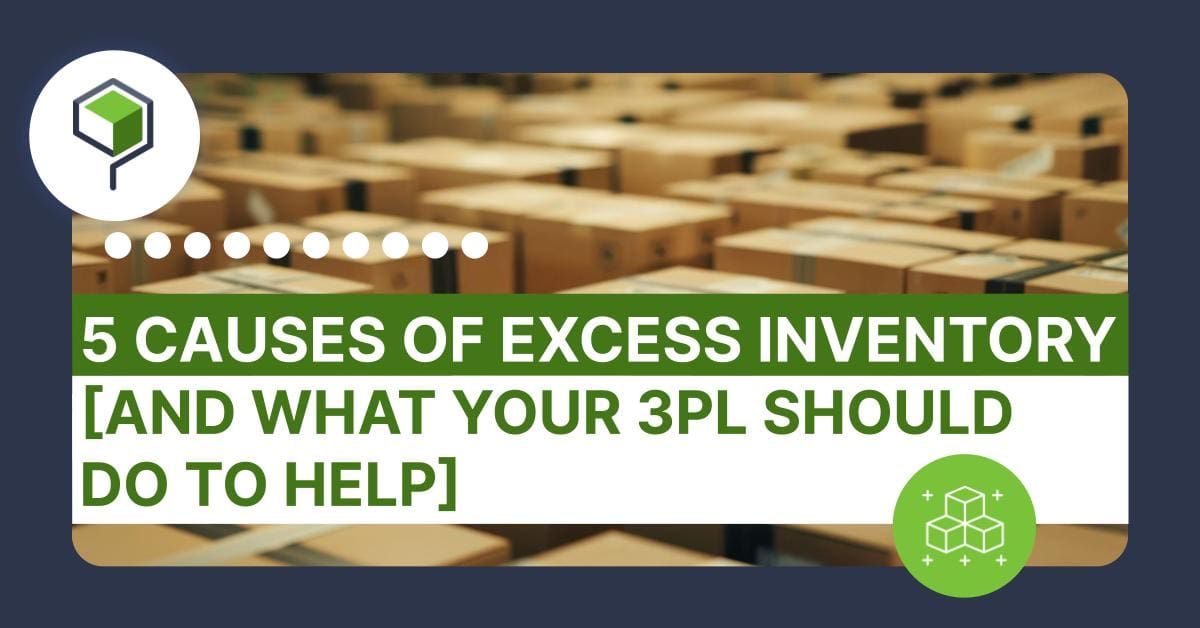5 Causes of Excess Inventory [and What Your 3PL Should Do to Help]

Too much inventory on the shelf? Excess inventory can strike even the most well-organized warehouse, especially in the aftermath of peak season or during the switch to fresh seasonal merchandise. When inventory on hand begins to spiral and storage space becomes limited, eCommerce businesses can find themselves needing to liquidate surplus inventory to make room for more stock, resulting in lower profit margins and more complex inventory management.
Struggles with excess stock when self-fulfilling or partnering with a (struggling) 3PL are very common in eCommerce, especially when working with highly trend-influenced products like apparel and cosmetics. So, what causes excess inventory to pile up? And what can a reliable 3PL do to avoid excess stock AND respond effectively when it does happen?
Cause 1. Setting incorrect reorder points for your inventory
Both seasonal and non-seasonal items in your inventory need an appropriate reorder point to meet customer demand and guard against stockouts. But if your reorder points are miscalculated, this can lead to either understocking – meaning that you miss out on valuable sales opportunities – or overstocking, leaving you with more inventory than there are sales.
Incorrect reorder points can happen for a variety of reasons but usually stem from a lack of sales data or visibility over inventory levels. For new products that haven’t been stocked before, brands may struggle to predict future demand patterns, leading to unbacked assumptions about consumer behavior. And if brands lack real-time inventory management capabilities, it’s difficult to set appropriate reorder points because information may lag behind actual stock levels, causing too much inventory to pile up.
Solution: Inventory analytics
Your 3PL should ensure solid excess inventory management by employing analytics tools to analyze historical sales data and access the turnover rate for different SKUs, ensuring that inventory levels are closely aligned with customer demand. Tracking how much inventory is on hand versus historical data can help you to identify where there might be a risk of excess inventory accumulating, meaning your brand can take action and create attractive offers to sell products that are sticking to the shelves.
Cause 2. Your SKUs are in the wrong place
If you’re running a multi-node fulfillment strategy, allocating the appropriate inventory to each facility can prove to be a major challenge. Depending on where your facilities are based, patterns in customer behavior and sales can vary significantly between locations. For example, swimsuits and flip-flops are more likely to see robust sales throughout the year in Florida compared to Minnesota. If your inventory assortment at each location doesn’t align with regional customer demand, you’re more likely to see certain products piling up in some locations, while selling out in others.
Solution: Shift inventory to other locations
When inventory is aging, it’s even more important to think about location and where excess stock is most likely to sell well. Your 3PL should closely monitor inventory turnover at each fulfillment location to see whether there are opportunities to move surplus inventory. Switching your slow-moving SKUs to less busy locations can make it easier to free up your key consumer hubs for more of your fast-moving SKUs that contribute the most to revenue. This also has the advantage of streamlining your fulfillment operation, as it’s easier to pick a smaller range of SKUs in higher volumes, meaning customers receive their orders more quickly.
Cause 3. It’s the end of the season
Seasonal inventory has a defined period of customer demand, whether that’s due to the weather, holiday events, or design trends. While this usually means high turnover for a period of weeks or months, there’s an inevitable slowdown in sales as the season comes to a close. Whether it’s winter coats in spring or swimsuits in fall, unsold seasonal merchandise is at risk of tying up valuable warehouse space and capital.
Solution: End of season and clearance sales
When the end of the season looms, consumers are primed to seek out products at a discounted price. So, putting excess stock on clearance to free up valuable storage space is both a great sales initiative and a way of reducing excess inventory. For example, an end-of-summer sale on select SKUs encourages customers to deplete surplus stock, especially if it comes with incentives like additional loyalty points or freebies. For extremely aging or high amounts of unsold inventory, you can add a clearance or “final sale” section of your site with even steeper discounts, but no availability to return or exchange.
It’s important to work with your 3PL as you plan end of season sales so that your partner is aware of which SKUs are going on sales and plan pick locations, fulfillment timeframes, and shipping cut-off times accordingly.
Cause 4. High return volumes
Excess inventory doesn’t just refer to inventory that doesn’t sell, but inventory that bounces back into the warehouse following an exchange or a return. However, returns don’t affect all SKUs equally; whether it’s due to an incorrect sizing chart, poor color fidelity, or a structural product fault, some products may be vulnerable to high return rates and inventory surplus. If your brand doesn’t have a streamlined process for managing returns, this merchandise is simply going to pile up in a back corner of the warehouse and cause issues for inventory management.
Solution: Solid returns management
Your 3PL partner should have robust returns management processes to not only process returns on the front end but also sort through returned merchandise once it arrives in the warehouse. This includes inspecting, categorizing, and disposing of returned items through resale, reconditioning, donation, or disposal as appropriate. This way, you can prevent pileups of excess inventory and maximize resale opportunities for returned goods.
Cause 5. Poor demand forecasting
When demand forecasts fail to align with actual market demand, eCommerce brands are left in a tough spot. Even when you have robust historical data, factors outside of your control such as economic downturns, weather events, or social media trends can cause demand patterns to do a complete 180. This can leave you with surplus stock that’s very difficult to shift.
Solution: Reposition the value of your inventory
Beyond outbound fulfillment logistics, 3PL partners have a variety of tools at their disposal to help change how excess inventory is perceived. Value-added services such as kitting, bundling, and subassembly can surplus inventory can take on a new value proposition in the eyes of customers. For example, bundling some socks that you have excess inventory of with a brand-new sneaker offers a convenient combo to customers, especially if it’s only costing them a little extra (probably still more than you could sell those socks for on their own!) This means more effective inventory management and more ability to take risks on new products.
Even with the best forecasting tools on your side, it isn’t always possible for eCommerce brands to anticipate sudden changes in demand or events that derail demand for certain SKUs. That’s why it’s important to partner with a 3PL that can offer both a proactive and reactive approach to managing excess inventory.
A fulfillment partner who can leverage strong inventory analytics to set the right reorder points and suggest timely promotions to shift inventory can nip too much stock in the bud before it becomes a problem, ensuring that storage costs stay under control.
However, any prospective 3PL should also have a range of solutions to handle extra inventory when it creeps up, such as vetting returned merchandise quickly to label items for resale, reconditioning, or donation instead of piling up in a forgotten corner of your warehouse. With the right value-added services, even last season’s SKUs can be repositioned as fun freebies or thank-yous, boosting customer satisfaction and helping to differentiate your brand in a competitive marketplace.
Excess inventory management isn’t just about shifting extra stock levels – it’s also about making sure that how you shift inventory is going to reinforce rather than damage your brand. By investing in a fulfillment partnership that prioritizes the brand experience, you can minimize inventory costs while also meeting customer demands.



